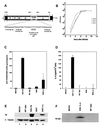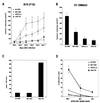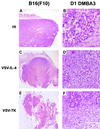Genetically engineered vesicular stomatitis virus in gene therapy: application for treatment of malignant disease
- PMID: 11752178
- PMCID: PMC136833
- DOI: 10.1128/jvi.76.2.895-904.2002
Genetically engineered vesicular stomatitis virus in gene therapy: application for treatment of malignant disease
Abstract
We report here the generation of recombinant vesicular stomatitis virus (VSV) able to produce the suicide gene product thymidine kinase (TK) or cytokine interleukin 4 (IL-4). In vitro cells infected with the engineered viruses expressed remarkably high levels of biologically active TK or IL-4 and showed no defects in replication compared to the wild-type virus. Recombinant viruses retained their ability to induce potent apoptosis in a variety of cancer cells, while normal cells were evidently more resistant to infection and were completely protected by interferon. Significantly, following direct intratumoral inoculation, VSV expressing either TK or IL-4 exhibited considerably more oncolytic activity against syngeneic breast or melanoma tumors in murine models than did the wild-type virus or control recombinant viruses expressing green fluorescent protein (GFP). Complete regression of a number of tumors was achieved, and increased granulocyte-infiltrating activity with concomitant, antitumor cytotoxic T-cell responses was observed. Aside from discovering greater oncolytic activity following direct intratumoral inoculation, however, we also established that VSV expressing IL-4 or TK, but not GFP, was able to exert enhanced antitumor activity against metastatic disease. Following intravenous administration of the recombinant viruses, immunocompetent BALB/c mice inoculated with mammary adenocarcinoma exhibited prolonged survival against lethal lung metastasis. Our data demonstrate the validity of developing novel types of engineered VSV for recombinant protein production and as a gene therapy vector for the treatment of malignant and other disease.
Figures





Similar articles
-
Development of recombinant vesicular stomatitis viruses that exploit defects in host defense to augment specific oncolytic activity.J Virol. 2003 Aug;77(16):8843-56. doi: 10.1128/jvi.77.16.8843-8856.2003. J Virol. 2003. PMID: 12885903 Free PMC article.
-
The oncolytic effect of recombinant vesicular stomatitis virus is enhanced by expression of the fusion cytosine deaminase/uracil phosphoribosyltransferase suicide gene.Cancer Res. 2003 Dec 1;63(23):8366-76. Cancer Res. 2003. PMID: 14678998
-
Vesicular stomatitis virus expressing interferon-β is oncolytic and promotes antitumor immune responses in a syngeneic murine model of non-small cell lung cancer.Oncotarget. 2015 Oct 20;6(32):33165-77. doi: 10.18632/oncotarget.5320. Oncotarget. 2015. PMID: 26431376 Free PMC article.
-
Vesicular stomatitis virus as an oncolytic vector.Viral Immunol. 2004;17(4):516-27. doi: 10.1089/vim.2004.17.516. Viral Immunol. 2004. PMID: 15671748 Review.
-
Oncotargeting by Vesicular Stomatitis Virus (VSV): Advances in Cancer Therapy.Viruses. 2018 Feb 23;10(2):90. doi: 10.3390/v10020090. Viruses. 2018. PMID: 29473868 Free PMC article. Review.
Cited by
-
Hippo signaling pathway regulates Ebola virus transcription and egress.Nat Commun. 2024 Aug 13;15(1):6953. doi: 10.1038/s41467-024-51356-z. Nat Commun. 2024. PMID: 39138205 Free PMC article.
-
Distinct roles for the NF-kappa B RelA subunit during antiviral innate immune responses.J Virol. 2011 Mar;85(6):2599-610. doi: 10.1128/JVI.02213-10. Epub 2011 Jan 5. J Virol. 2011. PMID: 21209118 Free PMC article.
-
Dynamics of melanoma tumor therapy with vesicular stomatitis virus: explaining the variability in outcomes using mathematical modeling.Gene Ther. 2012 May;19(5):543-9. doi: 10.1038/gt.2011.132. Epub 2011 Sep 15. Gene Ther. 2012. PMID: 21918546 Free PMC article.
-
NFAR-1 and -2 modulate translation and are required for efficient host defense.Proc Natl Acad Sci U S A. 2008 Mar 18;105(11):4173-8. doi: 10.1073/pnas.0711222105. Epub 2008 Mar 12. Proc Natl Acad Sci U S A. 2008. PMID: 18337511 Free PMC article.
-
Regulation of antiviral innate immunity by deubiquitinase CYLD.Cell Mol Immunol. 2011 Nov;8(6):502-4. doi: 10.1038/cmi.2011.42. Epub 2011 Sep 26. Cell Mol Immunol. 2011. PMID: 21946435 Free PMC article.
References
-
- Asnagli, H., and K. M. Murphy. 2001. Stability and commitment in T helper cell development. Curr. Opin. Immunol. 13:242–247. - PubMed
-
- Balachandran, S., and G. N. Barber. 2000. Vesicular stomatitis virus (VSV) therapy of tumors. IUBMB Life 50:135–138. - PubMed
-
- Balachandran, S., P. C. Roberts, L. E. Brown, H. Truong, A. K. Pattnaik, D. R. Archer, and G. N. Barber. 2000. Essential role for the dsRNA-dependent protein kinase PKR in innate immunity to viral infection. Immunity 13:129–141. - PubMed
MeSH terms
Substances
LinkOut - more resources
Full Text Sources
Other Literature Sources
Medical

